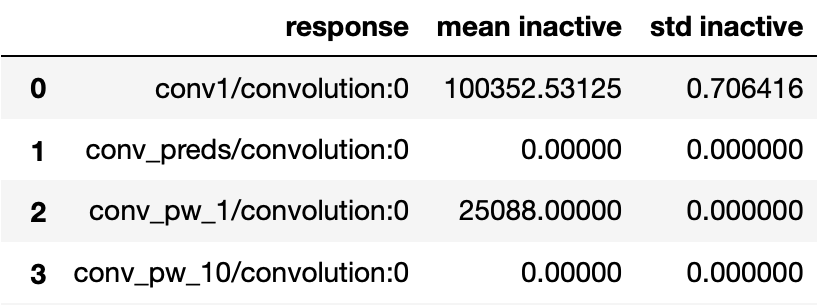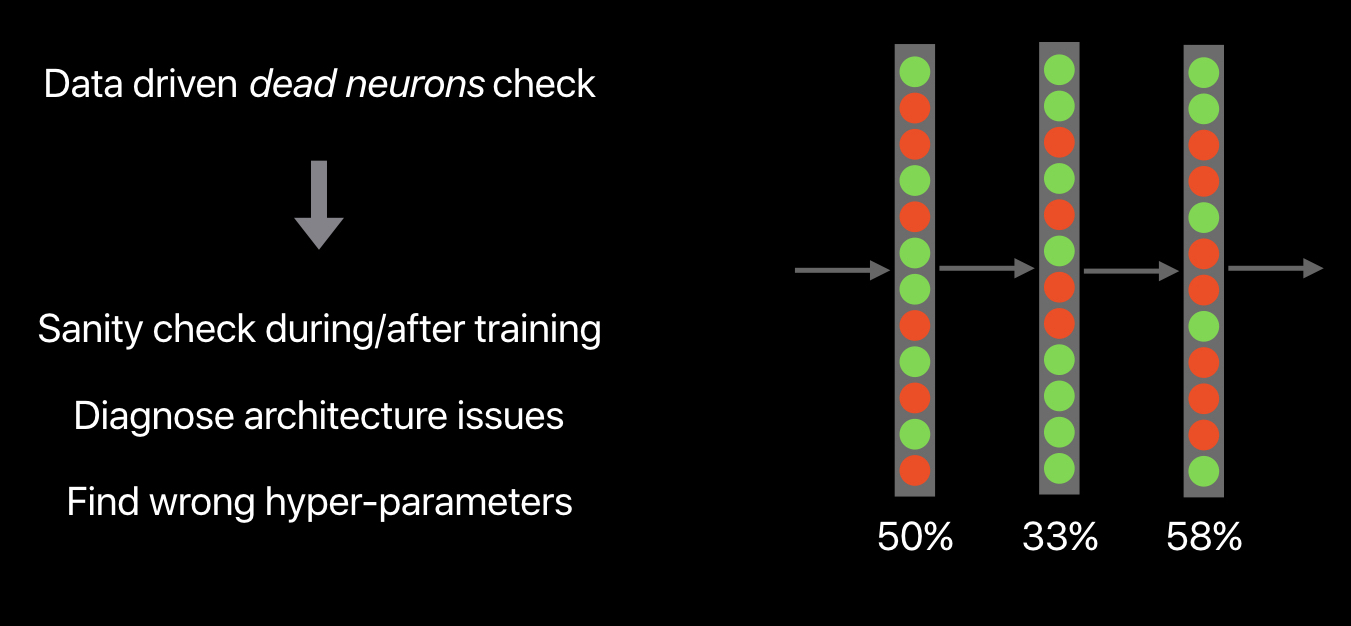Finding a Model’s Inactive Units#
Compute statistics about inactive units in a network as data is passed through (mean, standard deviation, counts, and unit frequency). IUA can be used to detect bad practices in training to avoid adverse effects, such as dying ReLU.
For more information about how the algorithm works and the motivation behind using it, please see the Description and Algorithm sections below.
General Usage#
Assuming a pipeline has been
set up to produce responses from a model,
IUA can be run as so:
from dnikit.introspectors import IUA
producer = ... # pipeline setup here
# Run IUA analysis on responses from a producer
iua = IUA.introspect(producer, batch_size=128)
For IUA, like PFA,
inputs to introspection should be prepared by selecting multiple
layer responses to analyze. Specifically, units of these layers will be
introspected. For instance, for a model
that uses Conv2D layers, one option could be selecting all the responses
for those layers by reviewing the DNIKit Model’s
.response_infos() and passing them where the model is
used in the pipeline, e.g.:
dnikit_model = ... # load model here
# Find only conv2d layer responses
response_infos = dnikit_model.response_infos()
conv_response_names = [
info.name
for info in response_infos.values()
if info.layer.kind == ResponseInfo.LayerKind.CONV_2D
]
producer = pipeline(
dataset,
...
# Tell the model which responses to look at
dnikit_model(conv_response_names),
...
)
Visualization#
The result of IUA.introspect
can be shown with IUA.show() directly, e.g.:
iua = IUA.introspect(producer, batch_size=64)
IUA.show(iua)

The IUA.VisType.CHART vis option can also be used to display
a heatmap of activations:
IUA.show(iua, vis_type=IUA.VisType.CHART)

Config options#
Like all introspectors, IUA takes
a Producer
as its first argument and an optional batch_size keyword argument
to set the size of batches pulled from the producer.
IUA also has two optional arguments, rtol and atol,
which are passed as parameters to the
numpy.isclose
method. This method determines what units count as “inactive” —which are effectively zero.
It’s recommended that only experienced users change these parameters.
For more information on their meaning, see the Notes section of the numpy.isclose
documentation.
Description#
ML researchers use a variety of information to make informed decisions about their model training and deployment. One such factor is the model capacity. However, when there are dead units in the model, the effective model capacity can be much smaller than first seems, and not an accurate depiction of the model’s state.
Inactive Unit Analysis (IUA) computes aggregate statistics about units’ responses to input probes, which can be used to evaluate how active the units are in response to the specified dataset. More inactive units indicates that model capacity is actually much smaller than intended. It may also indicate that there was a problem during training, such as dying ReLU. This could be caused a learning rate that is too high, so careful re-training might be necessary to achieve the desired accuracy.
Algorithm#
As data is passed through a model, IUA counts how many times each unit in the model is activated. After every data sample has passed through, IUA has a total number of times each unit has activated, for the number of input data samples. IUA then uses this information to compute aggregate statistics about how the units responded to the input data, including mean, std, proportion of inactive units, and raw count.
This information can be useful in assessing model health, as it can help identify when all (or nearly all) units in a layer are dead, e.g. after a ReLU.

Usage in DNIKit, see IUA API for more information.
from dnikit.introspectors import IUA
iua_results = IUA.introspect(
producer=response_producer, # only required arg
batch_size=32,
rtol: float = 1e-05,
atol: float = 1e-08
)